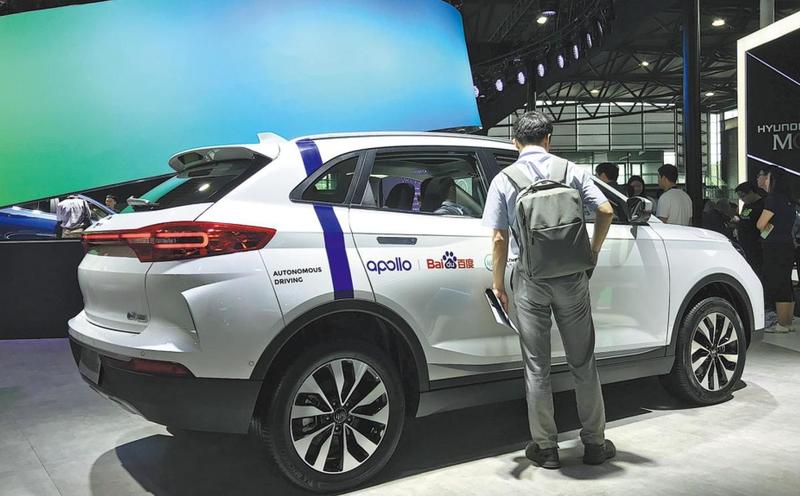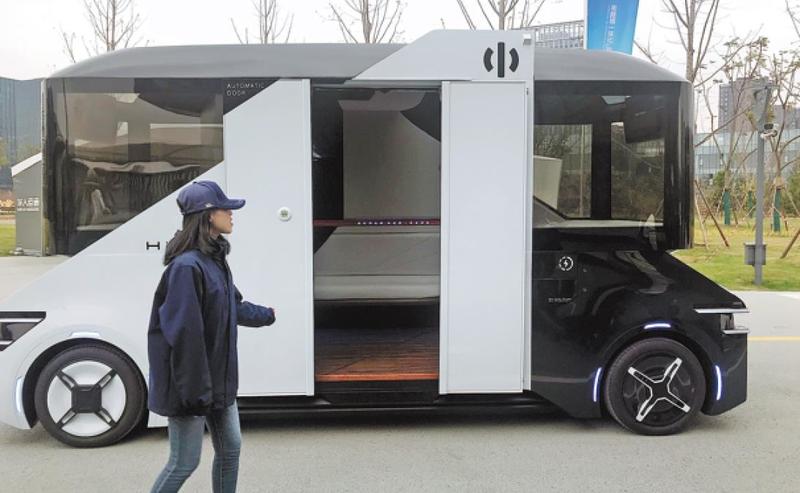 A visitor checks out a WM vehicle that sports Baidu's smart vehicle system at CES Asia in Shanghai in 2019. (LI FUSHENG / CHINA DAILY)
A visitor checks out a WM vehicle that sports Baidu's smart vehicle system at CES Asia in Shanghai in 2019. (LI FUSHENG / CHINA DAILY)
China is expected to complete the formulation of a framework for driving-assist functions and low-level autonomous driving by the end of 2020, according to the Ministry of Industry and Information Technology.
Investors have realized that autonomous driving will be implemented on a large scale over the next three to five years.
Han Xu, founder and CEO of WeRide
The ministry released the goal on Thursday as part of several major tasks it will focus on this year.
Specifically, the ministry will coordinate efforts in developing standards mainly for advanced driving assist systems, autonomous driving, information safety and connectivity and conduct pilot programs involving some carmakers and vehicles to evaluate the results.
The move is designed to further improve smart vehicle standards and pave the way for formulation of standards for high-level autonomous driving, the ministry said.
China unveiled an ambitious blueprint in February to develop its own standards for autonomous vehicles by 2025, covering technological innovation, infrastructure, legislation, supervision and network safety.
ALSO READ: Self-driving startup Pony.ai raises US$462m in Toyota-led funding
The country set a target to realize "scale production of vehicles capable of conditional autonomous driving and commercialization of highly autonomous vehicles in certain circumstances" by the end of the year.
The blueprint said China is expected to build a complete set of standards for autonomous vehicles between 2035 and 2050.
Autonomous driving is growing more popular in the capital market.
"Investors have realized that autonomous driving will be implemented on a large scale over the next three to five years," said Han Xu, founder and CEO of WeRide, a Chinese smart mobility company.
"They've also realized that it is no longer a high-risk investment and more capital is needed to expand business and boost technological stability."
Statistics from the China EV 100, an automotive think tank, show autonomous driving companies raised US$3.5 billion in the first quarter of this year, up 34 percent from the same period last year.
In China, Didi Chuxing received a US$300-million investment from Japanese tech giant Soft-Bank in March.
Pony.ai finished a new round of funding in February, raising US$462 million in investments, of which US$400 million came from Japanese automaker Toyota Motor Corporation.
After its latest round of fundraising, Pony.ai has a valuation of over US$3 billion.
The company is now providing an autonomous and contactless last-mile delivery service to customers in California, the United States. It is the first time the company has deployed its robotaxi fleet for the delivery of goods.
James Peng, CEO of Pony.ai, said Chinese autonomous driving companies are seeing rapid development and catching up with the global giants.
 An autonomous bus developed by Human Horizons stops for passengers at a smart park in Shanghai in 2019. (LI FUSHENG / CHINA DAILY)
An autonomous bus developed by Human Horizons stops for passengers at a smart park in Shanghai in 2019. (LI FUSHENG / CHINA DAILY)
He added China has several advantages in developing the technology, including the vast market demand, diverse traffic scenarios and the reserves of professionals in artificial intelligence.
"If you look around, if you will find that China is the only match for the US in terms of AI-related human resources," Peng said.
UISEE, another Chinese startup focused on high-level autonomous driving, also finished its round-B financing in February, securing tens of millions of dollars in investment from German industrial giant Bosch.
Wu Gansha, founder of the startup established in 2016, told local media that 2020 will mark the start of commercializing autonomous driving.
Thomas Fang, a partner in the China office of global consulting firm Roland Berger, said China's new infrastructure plan will further boost the development of autonomous driving in the country.
"Five out of seven aspects in the plan, including 5G, have something to do with smart vehicles," Fang said. He estimates that robotaxis will be the most important business mode for autonomous driving in the passenger vehicle market.
"Chinese people's enthusiasm for robotaxis is growing, from 25 percent in January 2017 to over 30 percent in July 2019 in surveys," Fang said. Roland Berger estimates that by 2030 smart vehicles could account for 41 percent of fleet operators and government agencies' purchases.
Consulting firm McKinsey said China has the potential to become the world's largest market for autonomous vehicles.
"In China, we believe fully autonomous vehicles will see mass deployment in nine or 10 years," analysts at the company wrote in a research note last year.
READ MORE: Smart vehicle strategy set to put China strides ahead
It expected such vehicles could account for as much as 66 percent of the passenger-kilometers traveled in 2040, generating market revenue of US$1.1 trillion from mobility services and US$0.9 trillion from sales of autonomous vehicles by that year.
In unit terms, that means autonomous vehicles will make up just over 40 percent of new vehicle sales in 2040, and 12 percent of the vehicle installed base, McKinsey said.


